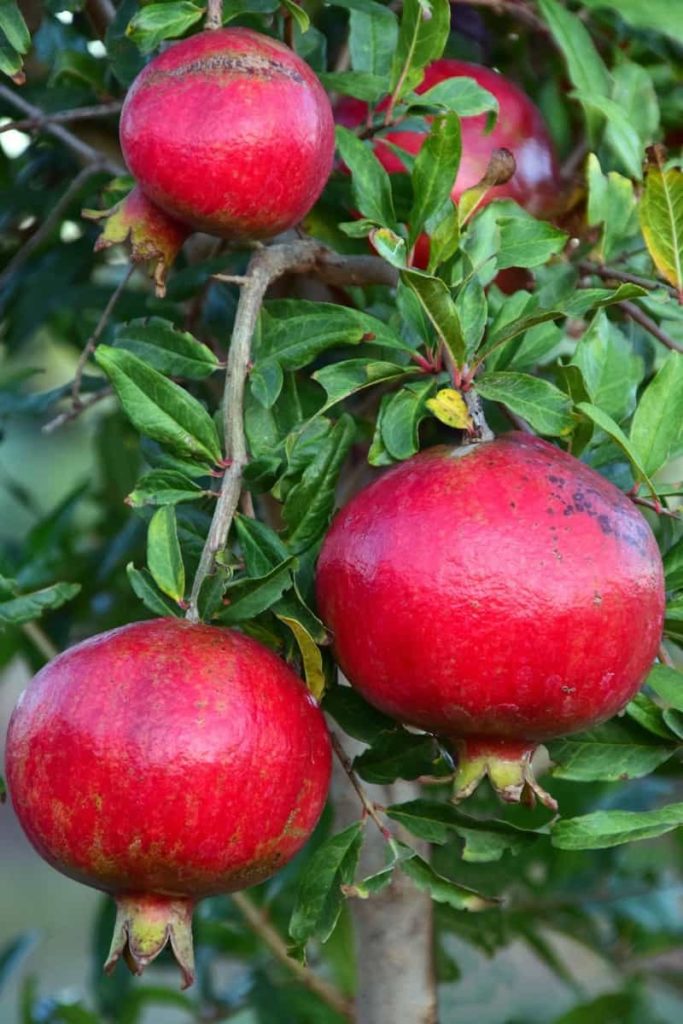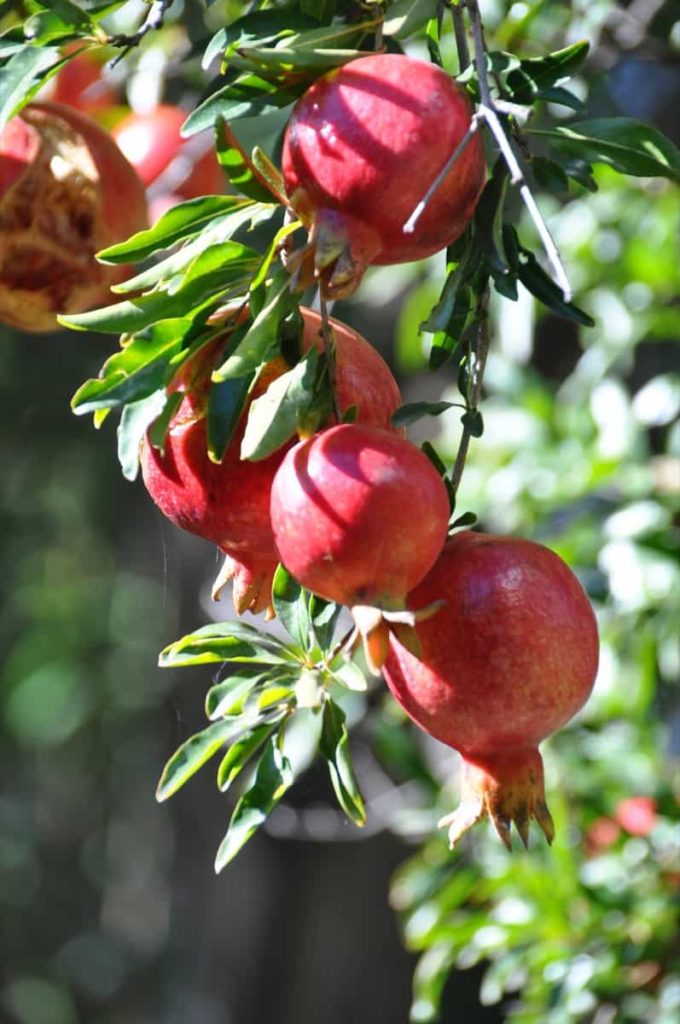It is scientifically known as Punica granatum and is an important fruit crop. Pomegranate can also be grown in less fertile soil. However, the recommended dose of chemical fertilizer should be added to the pit for better fruit production and quality. Manures and fertilizer diets vary depending on soil fertility types, genotypes, and area.
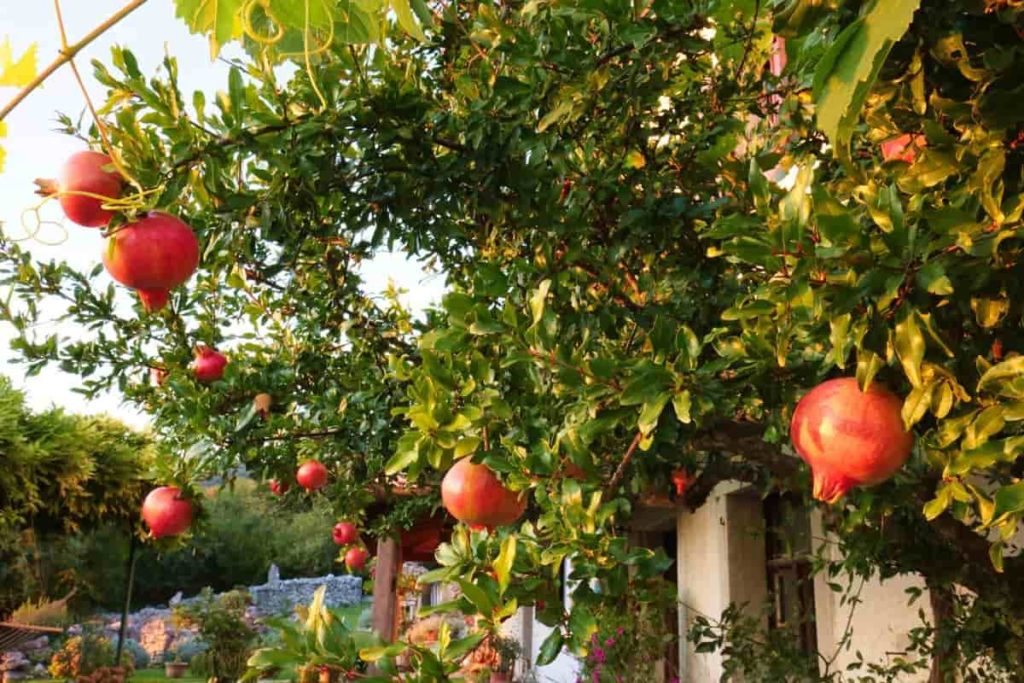
The tree needs basic care and occasional attention to thrive, but adhering to Pomegranate fertilizer schedules promotes healthy growth and fruit production. As the Pomegranate tree grows, it needs more fertilizer each year until you reach a maximum of 8 ounces in all three times of use. In the absence of rain, it is a good idea to water the tree well after each application so that the nutrients can reach the tree’s roots.
To produce healthy, well-ripened fruit for mature and fully ripe trees, there must be enough potassium available in the soil to maintain them, and it can be easily absorbed. Extra nutrients are beneficial during summer fruit production. Especially if the tree is bearing much fruit and you do not thin them out.
Fertilizer management in Pomegranate trees
NPK fertilizers
Nitrogen (N) and potassium (K)
Like all fruit trees, Pomegranate trees require a lot of nitrogen and enjoy acidic soils. Nitrogen helps in plant growth and development and can improve the quantity and quality of Pomegranate fruits. A balanced fertilizer containing nitrogen provides trees with everything they need to grow. If your soil is already rich in nitrogen, adding more can do more harm than good.
You can get a soil test kit to see how much nitrogen you naturally have. N and K are the essential nutrients for fruit production, including Pomegranate. N is an important component of leaf chlorophyll for umbrella growth to aid fruit growth. Potassium plays an important physical and molecular role in fruit growth, size, and quality.
Phosphorus (P)
Phosphorus is a component of nucleic acids and energy molecules – important for cell division and new tissue growth. Lack of phosphorus can lead to inadequate root development, weak winter hardiness, and slow maturity. The recommended dose of fertilizer is 600-700 grams of nitrogen, 200-250 grams of P2O5, and 200-250 grams of K2O / tree/year. Applying 10 kg of farmyard manure and 75 grams of ammonium sulfate is sufficient for a 5-year-old tree.
In case you missed it: Top 20 Steps to Boost Pomegranate Yield: How to Increase Pomegranate Fruit Size, Quality, and Production
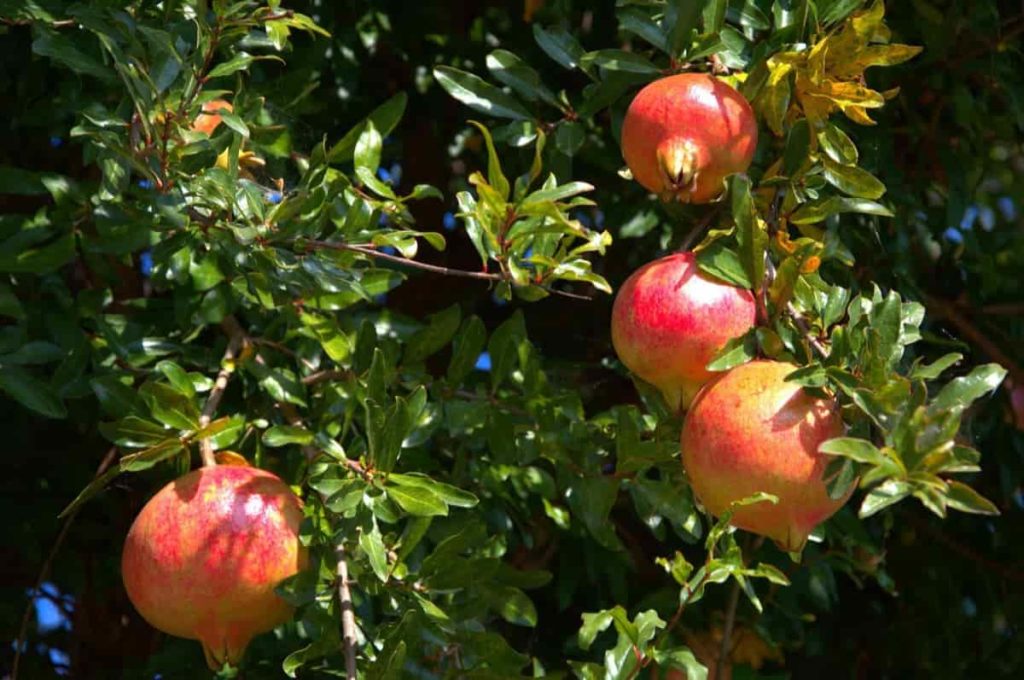
In comparison, 50 kg of farmyard manure and 3.5 kg of oil cake or 1 kg of ammonia sulfate before flowering are best for healthy growth and fruiting. Basal dose of farmyard manure by 25-40 cart loads/hectare. In addition, the recommended doses of N, P, and K should be applied to non-bearing trees in 3 split doses, which coincide with the growth of flushes during January, June, and September.
Fruit planting should be encouraged from the fourth year. Nitrogen fertilizer is applied in two doses, starting at the time of first irrigation after spring treatment and then at intervals of 3 weeks. In contrast, P and K should be fed simultaneously. They should be planted in a shallow round trench under the tree’s canopy, which should not be more than 8-10 cm deep. After application, the fertilizer is covered with topsoil and irrigated.
Pomegranate Fertilizer Schedule
Despite the low need for fertilizer, Pomegranate trees like it when you grow them with a nitrogen-rich fertilizer. When nitrogen enters the roots, it accelerates the process of photosynthesis, which makes the tree healthy. However, relying solely on nitrogen fertilizers is not an ideal thing. Therefore, you should mix it with other ingredients. Try to find a fertilizer that contains nitrogen, ammonium sulfate, and phosphorus.
While nitrogen takes care of the tree’s overall growth, phosphorus can increase flower production, eventually turning into fruit. But if you don’t want to go through the hassle of mixing ingredients, you can opt for pre-mixed fertilizers. A balanced 10-10-10 or 6-2-4 fertilizer would be best for this large shrub. Pomegranate trees require adequate nitrogen for optimal tree growth, as nitrogen helps plants grow and produce flowers that eventually set fruit.
You can use ammonium sulfate, a high nitrogen fertilizer, or a balanced 10-10-10 formula in the spring season when the Pomegranate tree begins to show new growth—applying 1 ounce of 10-10-10 fertilizer at 1 foot of plant height for a newly planted young tree. For example, if a Pomegranate plant is 3 feet tall, plant 3 ounces of 10-10-10. Make three applications at this rate, one in early spring, one in late spring, and one in early fall. Lightly scrape the manure in a 1-inch diameter circle with a Pomegranate bush in the middle of the circle.
Fertilization application
Chemical or Organic, whatever you choose, make sure it contains iron, zinc, manganese, magnesium, molybdenum, copper, and boron. These elements are important for plant growth. Application rates may vary.
10-10-10 or 10-0-10 with minerals
- About 1 cup per each year of the tree’s life
- Max out at 9 cups for the mature Pomegranate tree
Organic fertilizers
Fertilize Pomegranates just as they leaf out (around February) with a large covering of compost or use an organic fertilizer 2 to 3 times a year. Pomegranates prefer slightly acidic soils, so fertilizers that include used coffee grounds can be especially useful if you need to lower the pH from 5.5 to 7.0. Though, peat moss can be added as a two- to three-inch-thick top dressing and can be added to the soil in the spring season to accelerate the alkaline soil.
In case you missed it: Growing Dwarf Pomegranate – From Seed, Winter Care
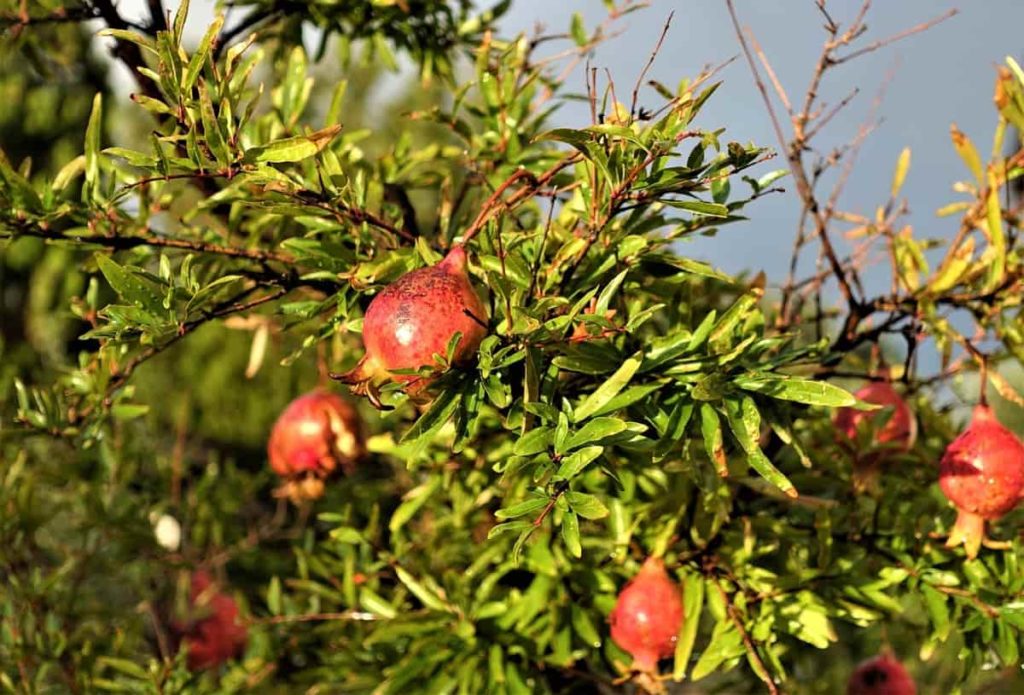
Shredded leaf mulch or well-aged manure added to the soil in late winter is one of the best sources of organic matter available that can even grow your tree or shrub before the onset of the growing season. Both can add more available nutrients, which feed the plant and the insects, and beneficial microbes that live in the soil around the plant. If you live in an area with low autumn and winter temperatures, leaf mulch and manure can help keep the plant’s roots well-insulated.
Espoma Citrus Tone (Organic)
- 6 cups for year old
- 10 cups for a 2-year-old (4-6 feet)
- 7-9 feet for tree 18 cups
- 24 cups for the tree over 9 feet
The fertilizer must be spread under the entire canopy, avoiding the nearest 5 inches. For zone 8a-10, apply fertilizer three times per year. Never fertilize after August. It can promote growth by the end of the year and damage the tree if it freezes.
Chemical fertilizers
Chemical fertilizers should be given according to the following recommendations for better growth and development.
| Fertilizers | One year plant | Five years & above plant |
| FYM | 50-60 kg | 50-60 kg |
| Urea | 10-20 gm | 50-60 gm |
| SSP | 150-300 gm | 900-1200 gm |
| MOP | 90-120 gm | 150 -200 grams |
Feeding tips for Pomegranate trees
Firstly, water is the most important nutrient for forming young Pomegranate trees, especially during the first year after planting. For established trees, proper irrigation, especially in dry periods, is critical for improving growth, fruit set, yield, and size. The fruits will drop prematurely and break if the trees do not get enough water during the dry spell. Pomegranate plants require very little fertilizer unless you have very sandy soil with good nutrient content.
The only factor they need is nitrogen, which will apply to plant age. Never fertilize your Pomegranate during the first year of its life. From the beginning of the second year, Pomegranate trees can be fed organic plant food or inorganic fertilizers such as slow-release shrubs and tree-type fertilizers. Alternatively, Pomegranate can be fed by mulching with organic fertilizer.
Remember that too much fertilizer is bad, so it is best to use as little as possible. Too much fertilizer will cause heavy plant growth, affecting fruit production and even causing the fruit to fall off prematurely. Applying too much fertilizer or more than recommended at the end of the year can result in late ripening of the fruit, leading to poor color and taste.
Homemade fertilizers for Pomegranate
You can use homemade compost or store-bought manure for Pomegranate trees. Depending on the soil quality and the environment, you may have better success with one or the other. If you select to make your own, add plenty of scrap from leafy greens and any ground coffee you have. For store-bought fertilizers, look for balanced 8-8-8 or 10-10-10 fertilizers. There is no reason to spend time making homemade fertilizer for your Pomegranate tree.
If you want to make your fertilizer or are already doing so, buy organic fertilizer or aged manure from the garden center. Spread it around the edge of the leafy canopy around the tree, but keep it a few inches away from the trunk. You will need sources of carbon and nitrogen to make your fertilizer. It’s a long process to make your compost, and you need space, usually 3-to-3-foot large bins. For nitrogen, save coffee grounds and other kitchen waste with manure and grass clippings. Apply them all together and leave the mixture on for several months.
In case you missed it: High Density Pomegranate Cultivation – In India
Making a Nitrogen-Rich Fertilizer
If your soil is particularly sandy and you know nutrients leach out quickly, you want to make a more nitrogen-rich fertilizer. Though, make enough fertilizer to cover about 100 square feet in a 5-gallon bucket, mix:
- Three-quarters of oil seed meal, such as cottonseed meal or soybean meal. Alternatively, use about 1 1/2 quarts of fish meal or feather meal. The latter is stronger and will smell just as strong. The combination of the two also works well, but going heavier on an oil seed meal, for example, 2-quart oilseed meal, 1-pint feather meal, and 1-pint fish meal;
- 1-Quart bone meal or rock phosphate; and
- 1-quart kelp meal, which provides trace minerals.
- Solomon also recommends adding lime to correct soil pH, but this is potentially unnecessary because Pomegranates have the potential to grow in soils with a wide range of pH level test values. Take a soil test, which you can buy from a local garden center.
How often should you fertilize the Pomegranate trees?
Fertilizer should be applied twice a year: early spring and early summer. Not Fertilization after August Late Fertilization can promote new growth, which can be subject to freezing damage. Fertilizer can be applied more frequently with fertigation. During the first year after planting, your Pomegranate trees grow and establish themselves. They do not need any additional fertilizer during this time except mulch or a layer of fertilizer.
During this year of rapid growth, your plant needs to change rapidly, and it is easy to add too many nutrients, which can stop growth. You are free to apply a small fertilizer amount during the second year of planting. Add 1 or 2 ounces in spring and autumn. For many trees, fertilizer is not needed at all. Although adding things to the soil that can benefit your plants may be tempting, it can burden the soil heavily. It is important to consider whether your plants need to be promoted.
If your trees are looking sick, not growing as expected, or if a soil test shows that you are deficient in the soil, fertilizer is an excellent option for you. Now you are ready for all your Pomegranate tree fertilizer needs. If you are deficient in the soil, or your trees are stunted or growing too slowly, a healthy fertilizer diet may be what your Pomegranate tree needs to become a fruit plant that you can grow. Some nitrogen-rich fertilizers or fertilizers that are applied in small amounts twice a year can help your Pomegranate trees flourish. Be careful not to overdo it.
Foliar application
After bloom, applying 11-16 kg/hectare of potassium nitrate can increase the fruit’s size and help prevent the fruit from splitting. Zinc is the most common deficiency. At least two foliar applications of zinc should be considered.
In case you missed it: Pomegranate Fruit and Flower Drop, Causes, Control
Liquid fertilizers
Some fertilizers are mixed with water and then sprayed on the soil. This type comes in a package of concentrate that can be attached to a hose for easy use. Other concentrated types may come with the scoop in powder form, and you will find instructions on the package on how many scoops to mix with a certain amount of water in the sprayer.
You can also find liquid fertilizers already thin and ready to spray without mixing. Generally, these liquids can be sprayed on the soil to cover the root system area. Other organic sources of nutrients that are soft and eco-friendly include fish emulsion, worm tea made by steeping harvested worm castings in watering plants with it, and compost tea which is formed by soaking a cloth “tea bag” full of compost in water and then watering Pomegranate plants with the solution.
Other fertilization methods used in Pomegranate trees
The nutrients for healthy plant growth include calcium, boron, manganese, magnesium, and zinc. Phosphorus is also an important nutrient of the plant. Deficient symptoms may include fruit breakage, leaf yellowing, and leaf spot. When nutrients like these are deficient, and your plants are under stress, you may also see an increased incidence of pest infestations and disease.
Another thing to understand is how the nutrients available in the soil affect the pH and how the roots of plants can absorb their needs from the soil, including water.
- Foliar K Spray – Increase fruit size and yield and reduce fruit splitting.
- Foliar sprays of Zn, Mn, B, and Cu when tissue analysis shows the deficiency
- Soil application of Fe chelates – safer and more reliable than foliar spray
- Compost
Troubleshooting for applying fertilizers to Pomegranate trees
Because the Pomegranate tree is drooping, losing leaves or poor growth is not a reason to apply fertilizer. If a nutrient deficiency is not a problem, too much fertilizer can worsen the problem. If the Pomegranate tree is not growing well or looks unhealthy, a soil test should be done to determine if malnutrition is causing the problem.
In case you missed it: Pomegranate Farming Project Report, Cost, Profit Analysis
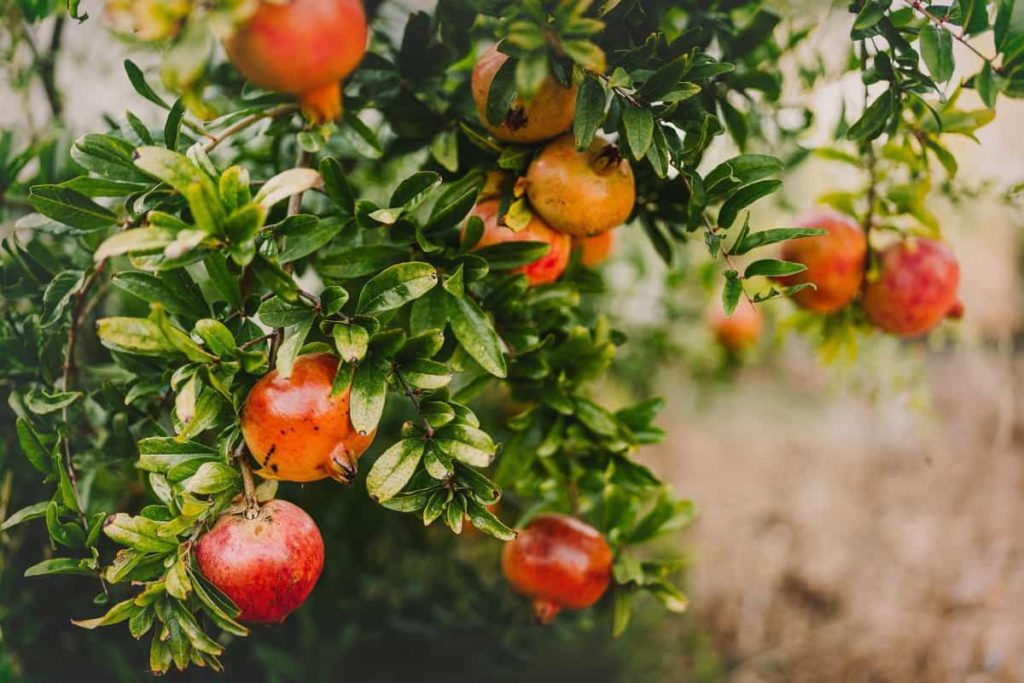
Local extension offices test the soil, identify nutrient, deficiency, and pH values and make recommendations to address any issues. Applying too much fertilizer can lead to overgrowth of the leaves, giving the plant a dense, bushy shape.
Conclusion
To meet these nutritional needs, pomegranate growers must plan and follow proper fertilizer management practices. You would like to meet some nutritional requirements to encourage optimal fruit production and promote optimal plant health. The Pomegranate tree needs a lot of nutrients to enhance the growth and quality of the fruit. Although Pomegranate trees do not need constant care, proper care can help the tree to produce more fruit.
- Economical Aquaculture: A Guide to Low-Budget Fish Farming
- 15 Common Planting Errors That Can Doom Your Fruit Trees
- How to Make Houseplants Bushy: Effective Tips and Ideas
- Innovative Strategies for Boosting Coconut Pollination and Yield
- Pollination Strategies for Maximum Pumpkin Yield
- The Complete Guide to Chicken Fattening: Strategies for Maximum Growth
- Natural Solutions for Tulip Problems: 100% Effective Remedies for Leaf and Bulb-Related Issues
- Revolutionizing Citrus Preservation: Towards a Healthier, Greener Future
- Natural Solutions for Peony Leaf and Flower Problems: 100% Effective Remedies
- Maximizing Profits with Avocado Contract Farming in India: A Comprehensive Guide
- Natural Solutions for Hydrangea Problems: 100% Effective Remedies for Leaf and Flowers
- The Ultimate Guide to Choosing the Perfect Foliage Friend: Bringing Life Indoors
- From Sunlight to Sustainability: 15 Ways to Use Solar Technology in Agriculture
- The Ultimate Guide to Dong Tao Chicken: Exploring from History to Raising
- The Eco-Friendly Makeover: How to Convert Your Unused Swimming Pool into a Fish Pond
- Mastering the Art of Delaware Chicken Farming: Essentials for Healthy Backyard Flocks
- 20 Best Homemade Fertilizers for Money Plant: DIY Recipes and Application Methods
- How to Craft a Comprehensive Free-Range Chicken Farming Business Plan
- Brighten Your Flock: Raising Easter Egger Chickens for Beauty and Bounty
- How to Optimize Your Poultry Egg Farm Business Plan with These Strategies
- Subsidy for Spirulina Cultivation: How Indian Government Schemes Encouraging Spirulina Farmers
- Ultimate Guide to Raising Dominique Chickens: Breeding, Feeding, Egg-Production, and Care
- Mastering the Art of Raising Jersey Giant Chickens: Care, Feeding, and More
- Ultimate Guide to Raising Legbar Chickens: Breeding, Farming Practices, Diet, Egg-Production
- How to Raise Welsummer Chickens: A Comprehensive Guide for Beginners
- How to Protect Indoor Plants in Winter: A Comprehensive Guide
- Ultimate Guide to Grow Bag Gardening: Tips, Tricks, and Planting Ideas for Urban Gardeners
- Guide to Lotus Cultivation: How to Propagate, Plant, Grow, Care, Cost, and Profit
- Agriculture Drone Subsidy Scheme: Government Kisan Subsidy, License, and How to Apply Online
- Ultimate Guide to Raising Araucana Chickens: Breed Profile, Farming Economics, Diet, and Care
- Bringing Hydroponics to Classroom: Importance, Benefits of Learning for School Students
- Ultimate Guide to Raising Polish Chickens: Breed Profile, Farming Economics, Diet, and Care
- Ultimate Guide to Raising Australorp Chickens: Profile, Farming Economics, Egg Production, Diet, and Care
- Silkie Chicken Farming: Raising Practices, Varieties, Egg Production, Diet, and Care
- Sussex Chicken Farming: Raising Practices, Varieties, Egg Production, Diet and Care
- Homemade Feed Formulations for Livestock: Discover Cost-effective Starter to Finisher Feed Recipes
